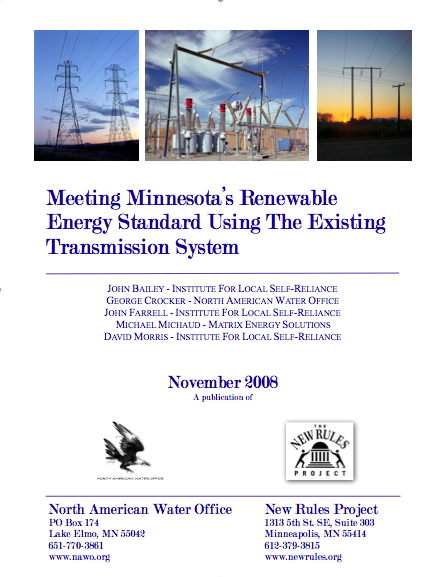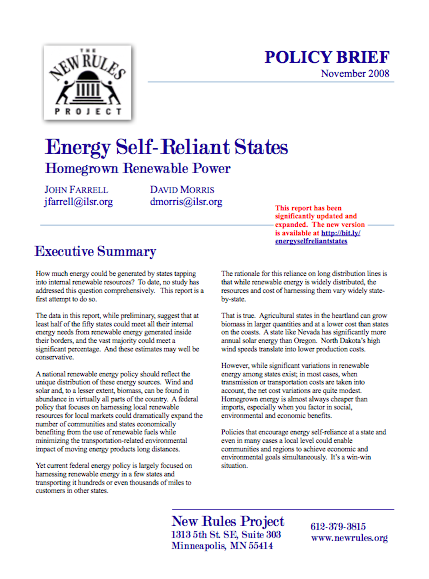This report was jointly authored with George Crocker of the North American Water Office and Michael Michaud of Matrix Energy Solutions.
The recent request by 11 utilities that own transmission lines in Minnesota and the surrounding region (CapX 2020) to build 650 miles of new high voltage transmission lines (mostly in Minnesota) is the first major transmission proposal in the state in 30 years and probably the largest, most costly transmission proposal ever in the state.
During those three decades Minnesota has painstakingly developed a comprehensive process for state electricity planning. The least cost process requires that any new generation or transmission project over a certain size be compared to alternative ways of meeting future energy needs. In that examination, a priority is given to improving energy efficiency and expanding distributed generation and the use of renewable fuels. The state also requires that a priority be given to strategies that expand locally owned renewable energy plants.
The current regulatory proceeding in Minnesota covers the first phase of the CapX 2020 vision, a phase the utilities argue is to meet Minnesota needs. But when fully built out CapX will be a multi-state transmission network designed to serve largely regional needs. Despite its regional orientation, individual segments of CapX 2020 lines must be approved by individual states. In evaluating the Phase I proposal, Minnesota regulators must rely on the state’s legislatively required need criteria and policy priorities.
One controversial issue related to the CapX proposal is whether new high voltage transmission lines are needed to meet Minnesota’s ambitious Renewable Energy Standard (RES) that requires 25 percent of state electricity consumption to be generated from renewable resources by 2020. Two recent, unprecedented transmission studies conducted by the state’s utilities provide empirical data that can be used to answer that question. These studies examined the potential for dispersed renewable electricity generation to be integrated into the existing transmission system.
The data generated by that examination leads to the conclusion that sufficient power transfer capability may be available on the existing grid or with relatively modest, strategic enhancements to the existing grid system to allow enough dispersed renewable electricity generation to meet the 2025 renewable energy goal without building major new 345 kV transmission facilities.
If completed as proposed, the CapX Phase I projects would provide an outlet for about 1,050 MW of additional capacity for renewable energy. The two utility-led studies suggest that this amount of renewable energy could be injected into the existing grid system with minimal transmission-related investments. With further study, we believe up to 3-5 times that amount of dispersed renewable energy projects can be connected to existing and any strategically-enhanced transmission/distribution lines at a cost less than would be incurred by continuing along the new transmission path envisioned by CapX.
Moreover, unless stringent conditions are tied to the approval of the new lines, the 1,050 MW of potential generation outlet is not guaranteed to be used for renewables; instead renewables will compete for transmission capacity with all types of non-renewable generation.
Vigorously pursuing a dispersed generation strategy for accomplishing our RES goals would allow the state to achieve several other legislated goals.
- Least cost. Since its cost could be a fraction of the cost of building a large, new network of high voltage transmission lines to achieve the RES goals, Minnesota ratepayers could save billions of dollars in avoided transmission line costs.
- Greenhouse Gas Reductions. By not establishing a potential energy delivery infrastructure, the dispersed and distributed generation strategy would significantly inhibit the construction of new large coal fired power plants that would deliver or pass carbon-based power through Minnesota, thereby helping Minnesota to achieve and remain firm in its greenhouse gas reduction goals.
- Local ownership. The dispersed generation strategy would enable a major expansion of locally owned wind turbines, an economic development goal the state legislature has formally adopted.
- Meeting the Near Term RES. Past practice has been that the regional transmission authority, the Midwest Independent Transmission System Operator (MISO), processed interconnection applications from power plant developers on a first come, first served basis. The result was a remarkably long queue in which locally owned and dispersed renewable electricity projects are near the back. All parties agreed that the queue process was broken.
MISO proposed and is in the process of implementing changes to the queue process but the effectiveness and results will not be known for months or years. One near term strategy would be to have the state assert authority over interconnection applications to existing subtransmission lines. By enabling the rapid interconnection of community based energy projects that can be shown not to cause grid reliability issues, this would achieve major in-state and community economic benefits and would enable new renewable power plants to more quickly come on-line, thereby meeting the near term generation requirements of the state RES.
A major investment in transmission might be needed in the future if a policy decision is made to transmit tens of thousands of MW of wind energy from the Dakotas to Illinois or Ohio, but at this date Minnesota should remain focused on meeting our own state’s aggressive state renewable energy goals. All of this renewable energy should and could be generated inside Minnesota, thereby keeping substantial economic benefits right here rather than sending them off to other states.




